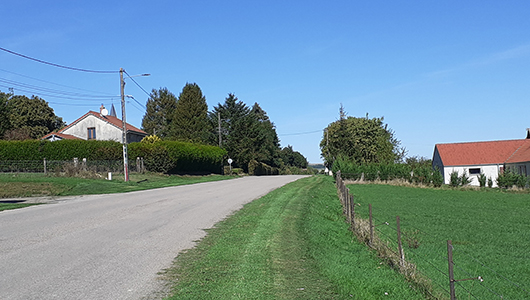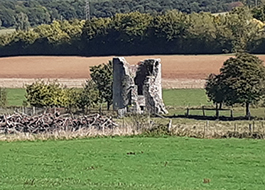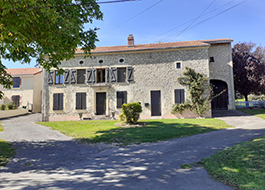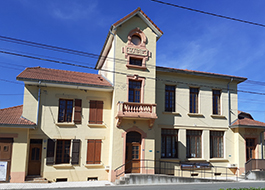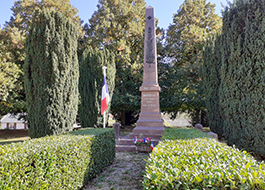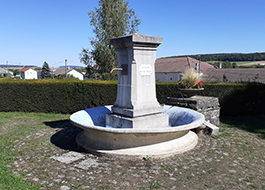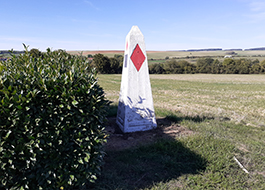Bantheville
Durée visite : 70 minutes
Moyen : Pédestre
Bantheville est le village natal de Richard, abbé de Saint-Vanne de Verdun, grand réformateur monastique du XIe siècle. Affranchi en 1250, la localité est un enjeu incessant entre la Champagne et la Lorraine. En 1629, les Allemont succèdent aux Pouilly comme seigneurs du bourg. Au XIXe siècle, la commune abrite une tuilerie, une scierie et une fromagerie.
Bantheville is the native village of Richard, abbot of Saint-Vanne de Verdun, a great monastic reformer of the 11th century. Freed in 1250, the locality is an incessant stake between Champagne and Lorraine. In 1629, the Allemonts succeed the Pouillys as lords of the village. In the 19th century, the town housed a tile factory, a sawmill and a cheese factory.
Bantheville ist das Geburtsdorf von Richard, Abt von Saint-Vanne de Verdun, einem großen Klosterreformer des 11. Jahrhunderts. Die 1250 befreite Ortschaft stellt einen unaufhörlichen Pfahl zwischen Champagne und Lothringen dar. 1629 folgen die Allemonts den Pouillys als Dorfherren. Im 19. Jahrhundert beherbergte die Stadt eine Ziegelei, ein Sägewerk und eine Käserei.

D’azur à la fasce ondée d’argent chargée de deux fers de moulin de sinople, accompagnée en chef d’un lion issant d’or, armé et lampassé de gueules et en pointe d’une tour d’or maçonnée de sable.
Azure a fess wavy Argent charged with two mill irons Vert, accompanied in chief by a lion issuant Or, armed and langued Gules and in base by a tower Or masonry Sable.
Azurblau ein fess welliges Argent, das mit zwei Mühleisen Vert beladen ist, begleitet als Häuptling von einem Löwen, der Or, bewaffnet und schmachtend Gules und in der Basis von einem Turm oder Mauerwerk Sable.

Les habitants de Banthéville s’appellent les Banthevillois et les Banthevilloises.
The inhabitants of Banthéville are called Banthevillois and Banthevilloises.
Die Einwohner von Banthéville werden Banthevillois und Banthevilloises genannt.
Les points de visites
.
Le château de Bolandre, édifié à une date inconnue, est une forteresse aux tours puissantes et aux fossés profonds, remplis par les eaux de l’Andon. En 1785, il appartient à Louis-Mathieu Godefroy. Il change plusieurs fois de mains après la Révolution. En très mauvais état, il est démoli en 1869. Les pierres sont réutilisées pour une ferme voisine. Il ne reste que les vestiges de cette tour.
The castle of Bolandre, built at an unknown date, is a fortress with powerful towers and deep ditches, filled by the waters of the Andon. In 1785, it belonged to Louis-Mathieu Godefroy. It changed hands several times after the Revolution. In very poor condition, it was demolished in 1869. The stones were reused for a neighboring farm. Only the remains of this tower remain.
Die zu einem unbekannten Zeitpunkt erbaute Burg von Bolandre ist eine Festung mit mächtigen Türmen und tiefen Gräben, die vom Wasser des Andon gefüllt sind. 1785 gehörte es Louis-Mathieu Godefroy. Nach der Revolution wechselte es mehrmals den Besitzer. In sehr schlechtem Zustand wurde es 1869 abgerissen. Die Steine wurden für einen benachbarten Bauernhof wiederverwendet. Von diesem Turm sind nur noch die Überreste erhalten.
.
Cette jolie bâtisse en pierre est bien restaurée. Elle dispose de deux portes piétonnes. La grange est en retrait de la façade. Le poirier est un élément indissociable de la façade rurale lorraine. Il est une pompe écologique et un climatiseur naturel. Le feuillage apporte fraîcheur en été. L’absence de feuille, en hiver, permet aux rayons du soleil de réchauffer la façade.
This pretty stone building is well restored. It has two pedestrian doors. The barn is set back from the facade. A pear tree provides shade and coolness to the room on the right.
Dieses hübsche Steingebäude ist gut restauriert. Es hat zwei Fußgängertüren. Die Scheune ist von der Fassade zurückgesetzt. Ein Birnbaum spendet dem Raum rechts Schatten und Kühle.
.
Bénie en 1746, l’église précédente est détruite pendant la Première Guerre. Elle est rebâtie à la fin du conflit. Elle est dédiée à Saint Remi qui est le saint patron du village. Il est aussi l’un des cinq patrons catholiques de France.
Blessed in 1746, the previous church was destroyed during the First World War. It was rebuilt at the end of the conflict. It is dedicated to Saint Remi who is the patron saint of the village. He is also one of the five Catholic patrons of France.
1746 gesegnet, wurde die Vorgängerkirche im Ersten Weltkrieg zerstört. Es wurde am Ende des Konflikts wieder aufgebaut. Es ist dem Heiligen Remi gewidmet, dem Schutzpatron des Dorfes. Er ist auch einer der fünf katholischen Patrone Frankreichs.
.
Cette mairie abritait jadis une école. Elle est aujourd’hui désertée par les petits Banthevillois. Le bâtiment n’en demeure pas moins intéressant. Au XIXe siècle, les lois scolaires ont donné des indications précises pour la construction de tels complexes. Des architectes, tels qu’Auguste Bouillon ou Félix Narjoux, ainsi que le Conseil des Bâtiments publics, ont édité des plans-types et des descriptions de bâtiments déjà construits. Le choix des matériaux à utiliser, pour un résultat de qualité et en harmonie avec l’environnement, est aussi informé.
This town hall once housed a school. It is now deserted by the little Banthevillois. The building is no less interesting. In the 19th century, the school laws gave precise indications for the construction of such complexes. Architects, such as Auguste Bouillon or Félix Narjoux, as well as the Conseil des Bâtiments publics, published standard plans and descriptions of buildings already constructed. The choice of materials to be used, for a quality result and in harmony with the environment, is also informed.
Dieses Rathaus beherbergte einst eine Schule. Es ist jetzt von den kleinen Banthevillois verlassen. Das Gebäude ist nicht weniger interessant. Im 19. Jahrhundert gaben die Schulgesetze genaue Vorgaben für den Bau solcher Anlagen. Architekten wie Auguste Bouillon oder Félix Narjoux sowie der Conseil des Bâtiments publics veröffentlichten Standardpläne und Beschreibungen bereits errichteter Gebäude. Die Wahl der zu verwendenden Materialien für ein qualitativ hochwertiges Ergebnis und im Einklang mit der Umwelt wird ebenfalls informiert.
.
Daté de 1930, cet obélisque en marbre évoque la mémoire des Banthevillois morts en 14-18. En septembre 1914, un officier allemand est enterré dans le village. La garde d’honneur tire une salve de mousqueterie. Des Allemands, venant des Ardennes, croient à une agression de civils. Ils incendient les maisons. Puis, ils prennent 12 otages, dont 5 sont fusillés. Par la suite, des officiers allemands reconnaissent une erreur malheureuse. Cette histoire confirme la terreur des troupes du Kaiser pour d’éventuels francs-tireurs. Les noms des victimes sont gravées sur le monument. Jules Détante est tué au Mort-Homme en mai 1916. Il est le fils d’un des habitants exécuté en 1914, Narcisse. Un autre fusillé, Emile Watrin, avait 14 ans.
Dating from 1930, this marble obelisk evokes the memory of the Banthevillois who died in 14-18. In September 1914, a German officer was buried in the village. The honor guard fires a volley of musketry. Germans, coming from the Ardennes, believe in an attack on civilians. They burn the houses. Then they take 12 hostages, 5 of whom are shot. Subsequently, German officers recognize an unfortunate mistake. This story confirms the terror that the Kaiser’s troops have of potential snipers. The names of the victims are engraved on the monument. Jules Détante was killed at Mort-Homme in May 1916. He was the son of one of the inhabitants executed in 1914, Narcisse. Another shot, Emile Watrin, was 14 years old.
Dieser Marmorobelisk aus dem Jahr 1930 erinnert an die Banthevillois, die zwischen 14 und 18 starben. Im September 1914 wurde ein deutscher Offizier im Dorf begraben. Die Ehrengarde feuert eine Musketensalve ab. Deutsche, die aus den Ardennen kommen, glauben an einen Angriff auf Zivilisten. Sie brennen die Häuser ab. Dann nehmen sie 12 Geiseln, von denen 5 erschossen werden. Anschließend erkennen deutsche Offiziere einen unglücklichen Fehler. Diese Geschichte bestätigt den Schrecken, den die Truppen des Kaisers vor potenziellen Scharfschützen haben. Die Namen der Opfer sind auf dem Denkmal eingraviert. Jules Détante wurde im Mai 1916 in Mort-Homme getötet. Er war der Sohn eines der 1914 hingerichteten Bewohner, Narcisse. Ein anderer Schütze, Emile Watrin, war 14 Jahre alt.
.
Datée de 1930, cette construction a une origine incertaine.Un puits aurait existé à cet emplacement. La fontaine, de forme parallélépipédique, est édifiée par Monsieur Bourgoin-Desailly, qui exprime peut-être ainsi sa reconnaissance envers la commune, sur le territoire de laquelle il aurait exploité des coquins. Ceux-ci sont des roches de phosphate, dont la forme rappelle celle des rognons.
Dated 1930, this construction has an uncertain origin. A well would have existed at this location.
The fountain, parallelepiped in shape, was built by Mr. Bourgoin-Desailly, who perhaps expresses his gratitude to the town, on whose territory he allegedly exploited rogues. These are phosphate rocks, whose shape is reminiscent of kidneys.
Diese Konstruktion stammt aus dem Jahr 1930 und ist ungewiss. An dieser Stelle hätte ein Brunnen gestanden.
Der quaderförmige Brunnen wurde von Herrn Bourgoin-Desailly gebaut, der vielleicht seine Dankbarkeit gegenüber der Stadt ausdrückt, auf deren Territorium er angeblich Schurken ausgebeutet hat. Das sind Phosphatgesteine, deren Form an Nieren erinnert.
.
Cet obélisque est repérable par son grand losange rouge. C’est l’emblème de la 5e Division d’Infanterie des Etats-Unis. Ces bornes sont disposées tout au long du parcours de l’unité, lors de son engagement, à partir de juin 1918. C’est l’association de ses vétérans qui en est à l’origine. C’est la plus ancienne organisation de ce type aux USA. Le 12 septembre, l’unité fait partie d’une attaque majeure qui réduit le saillant de Saint-Mihiel. La division a servi dans l’armée d’occupation, étant basée en Belgique et au Luxembourg, jusqu’à ce qu’elle soit inactivée en Europe en octobre 1921.
This obelisk is identifiable by its large red diamond. It is the emblem of the 5th Infantry Division of the United States. These terminals are arranged throughout the course of the unit, during its engagement, from June 1918, in the liberation of France. On September 12, the unit was part of a major attack that reduced the Saint-Mihiel salient.
The division served in the Army of Occupation, being based in Belgium and Luxembourg, until it was inactivated in Europe in October 1921.
Dieser Obelisk ist an seinem großen roten Diamanten zu erkennen. Es ist das Emblem der 5. Infanteriedivision der Vereinigten Staaten. Diese Terminals sind im Verlauf der Einheit während ihres Engagements ab Juni 1918 bei der Befreiung Frankreichs angeordnet. Am 12. September war die Einheit Teil eines Großangriffs, der den Vorsprung von Saint-Mihiel reduzierte.
Die Division diente in der Besatzungsarmee mit Stützpunkten in Belgien und Luxemburg, bis sie im Oktober 1921 in Europa inaktiviert wurde.
.

